Introduction
- Advanced nursing practice;
- Theory development and exploring models and philosophies (Butts & Rich, 2015);
- Analyze Jean Watson’s theory and practice model;
- Provide a personal philosophy of advanced nursing.
Hello, my name is STUDENTNAME. I study advanced nursing practice to graduate as a master. The exploration of theory development, models, and philosophies in the context of advanced nursing practice is the essential aspect of my learning track. I chose Jean Watson’s theory of human caring because it is a framework that could be efficiently applied to practice. This presentation includes the analysis of Jean Watson’s theory and practice model and also a personal philosophy of advanced nursing which reflects my vision of nursing profession.
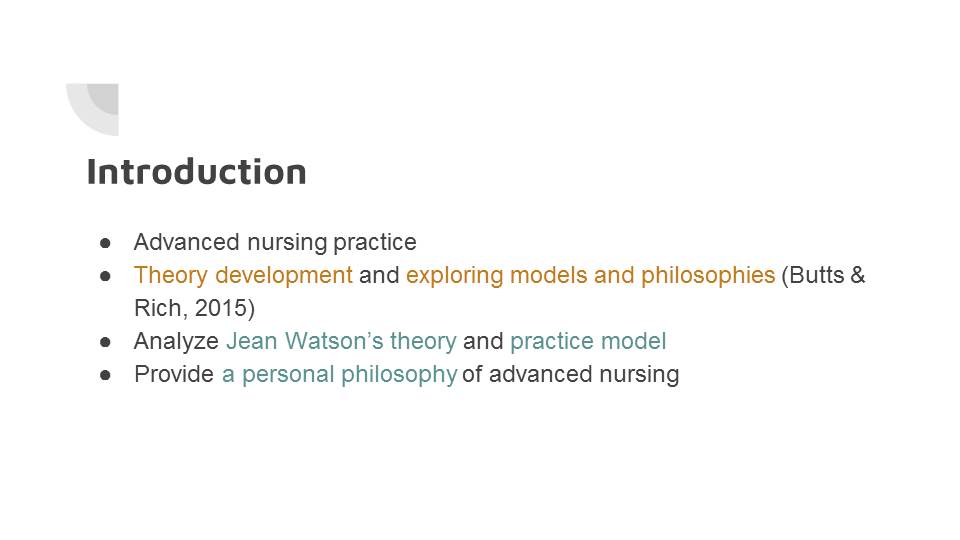
Caring and Healing Model
- Part of Watson’s theory of human caring;
- Practical guide for nurses (Butts & Rich, 2015);
- Assessment;
- Plan;
- Intervention;
- Evaluation.
Caring and Healing model is an integral part of Jean Watson’s theoretical framework. The model was developed so that it could efficiently guide nursing professionals in their practice. Comprising four stages, (assessment, plan, intervention, and evaluation), the implementation of the model in clinical settings is highly acclaimed (Black, 2014).
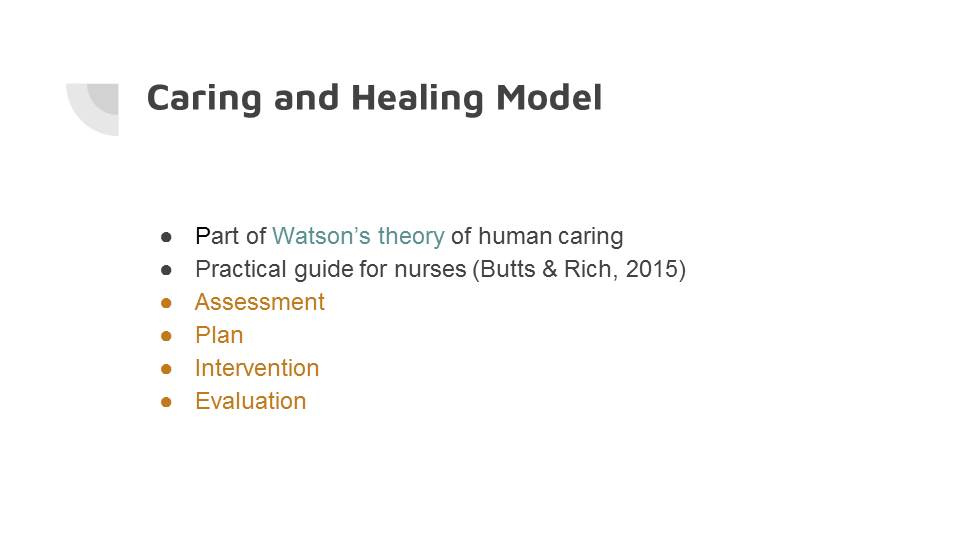
Implementation and Rationale for Choosing
- Assessment: identification of the problem;
- Plan: projecting actions;
- Intervention: implementation of the plan;
- Evaluation: assessment and interpretation of results;
- Part of the holistic nursing theory (Butts & Rich, 2015);
- Strong theoretical basis fundamental for practice.
It is critical to briefly observe the practical implementation of each of the model’s stages. The existing problem is identified through the communication with the patient in the assessment phase. On the basis of the gathered information, a comprehensive plan is developed. Then, it is implemented in the practice, with particular focus on emotional support. Finally, the results of the treatment are evaluated in order to facilitate future practice.
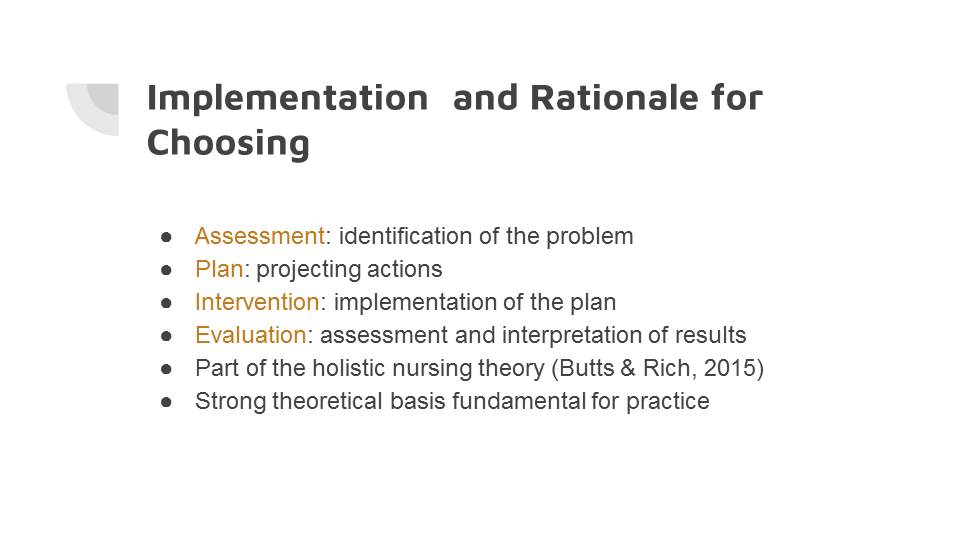
Watson’s Theory of Human Caring
- Jean Watson started to develop her theory since 1979 (Wagner, 2010);
- The theory represents Watson’s holistic approach to nursing (Wagner, 2010);
- It is chosen because it comprises a broad set of theoretical assumptions and guidelines;
- The theory is significantly elaborated and has practical implications.
Jane Watson started to develop her approach since 1979, and, to the present day, the theory is still evolving and being elaborated. In general, the method represents Jean Watson’s holistic approach to nursing. She understands the ultimate goal of any nurse as delivering patient-centered care. The theory is well-elaborated, and it comprises a broad set of theoretical assumptions and guidelines that have significant implications for nursing practice. Also, it could be applied to nearly any nursing environment.
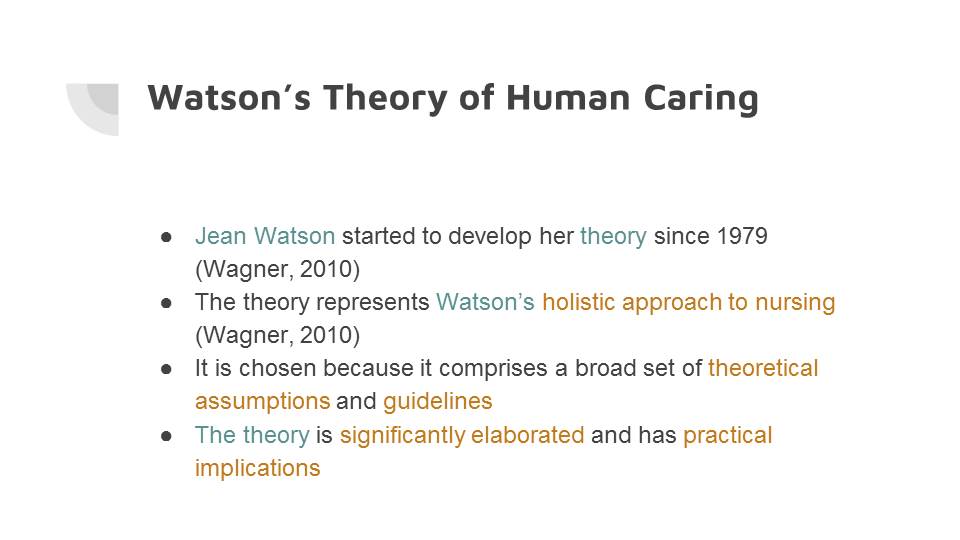
Four Concepts of Nursing in the Context of the Theory
- Human being: a person with the integral right for respect and care;
- Health: the complex of physical, mental, and social factors;
- Environment: nursing as an integral part of society;
- Nursing: focus on health promotion, caregiving, and disease prevention.
The interpretation of the core concepts of the nursing science is highly important for the understanding of the theory. One of the most important ideas is the interpretation of the human being concept. Watson’s theory is patient-centered since it perceives human being as a highly valued person who has to be treated with dignity, respect, care, and understanding. Health is defined as the absence of illness and the proper functioning of physical, mental, and social systems of a human being. Concerning the concept of environment, Jean Watson considers nursing to be an integral part of any society and caregiving is one of the basic social needs. Nursing is interpreted as a theoretical and practical system, which aims to promote health, provide care, and prevent diseases.
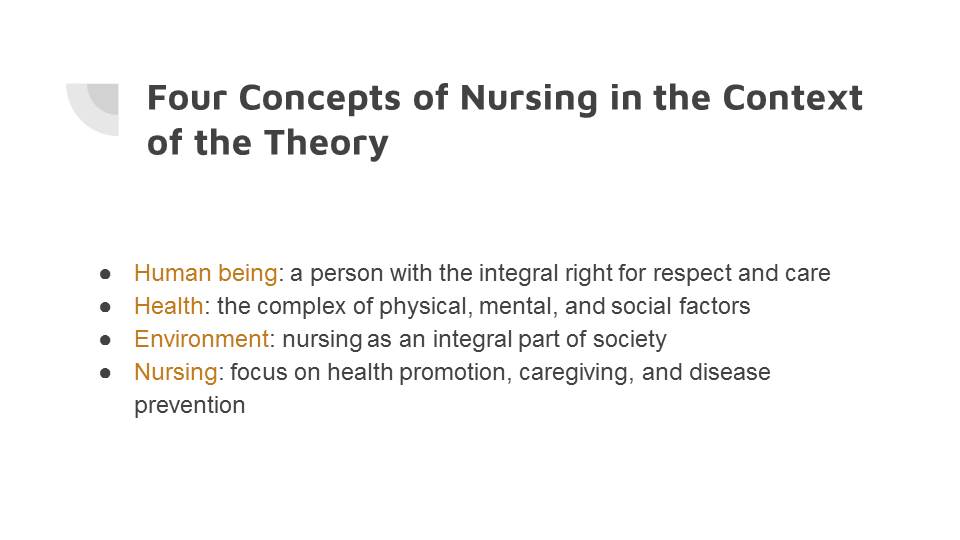
Ten Caritas Processes
- Carative factors evolved into caritas processes (Wagner, 2010);
- Core ideas of Jean Watson about nursing;
- Philosophical basis of the theory and its the implications (Wagner, 2010).
The set of ten Caritas Processes is another essential aspect of the theory under discussion. These assumptions can be considered as the core ideas of Jane Watson about philosophical, theoretical, and practical spheres of nursing. Also, it is worth mentioning that these assumptions were called carative factors when the theory was created. However, they evolved into caritas processes over time. It is possible to observe that the first three processes represent the philosophical basis of the theory, and the other seven are the implications which derive from Watson’s philosophy.
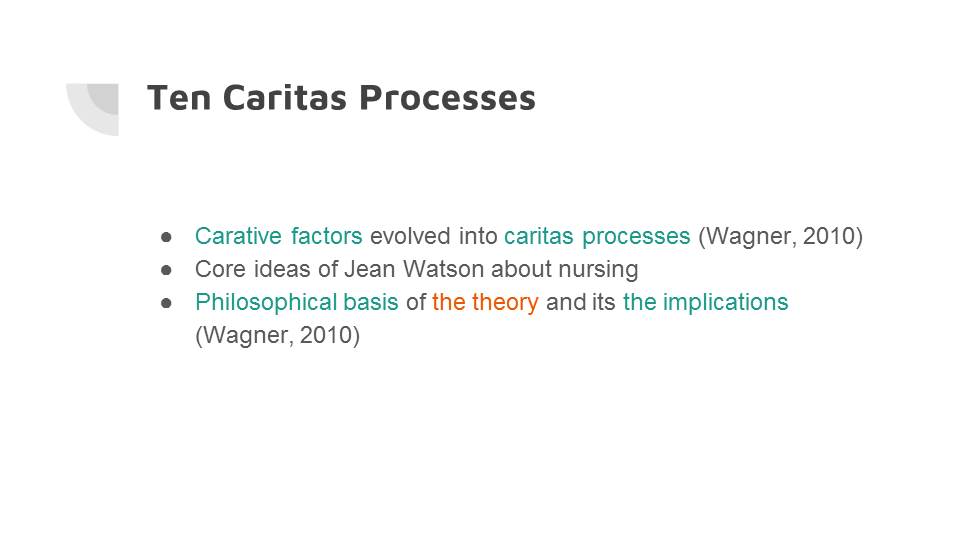
Research and Practice in the Context of the Theory
- Successful application to the contemporary scientific research;
- The article by Brewer and Watson (2015);
- Successful application to practice as well;
- Positive about the implementation of the approach.
As it is apparent that the theoretical framework under discussion is practice-oriented. For example, Brewer and Watson (2015) implemented the human caring theory to conduct research, aiming to improve the communication between clinical staff and patients. The results were significantly positive. It is evident that the theory is capable of using it in the contemporary nursing environments, and thus I will use it in my practice after graduation. As an advanced practice nurse, I would use the theory to improve the communication with patients and establish trusting relationships with them.
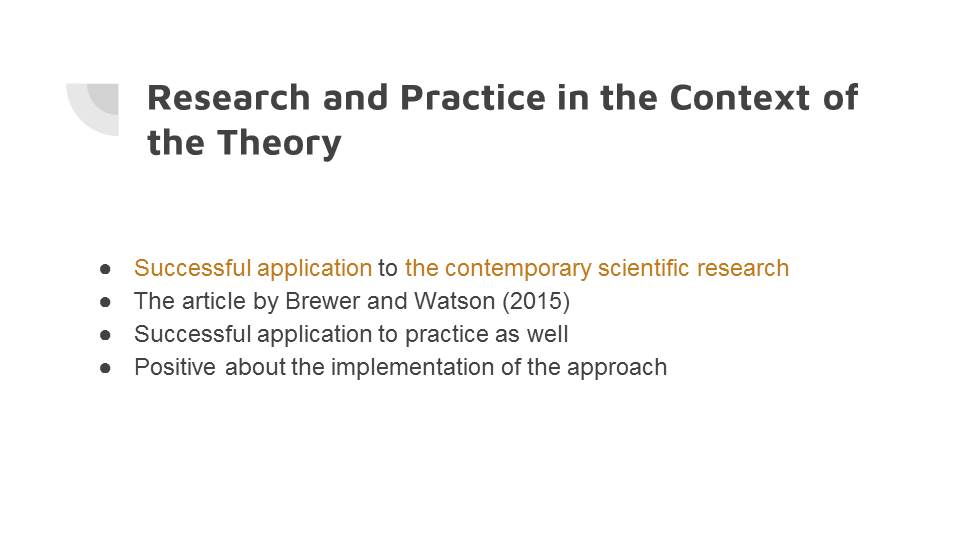
Personal Philosophy of Advanced Nursing Practice
- Personal philosophy defined as holistic and patient-centered (Papathanasiou, Kourkouta, & Sklavou, 2013);
- Significantly impacted by Watson’s theory;
- The focus on the personhood of my patients;
- Health, environment, and nursing guided by the patient’s needs.
After graduation, I will be the advanced practice nurse, and I think that it is essential to use holistic and patient-centered approach. I consider advanced nursing practice to be guided by the patient’s needs; therefore, other aspects of the nursing metaparadigm are dependent on the person. I will focus on the personhood of my patients to deliver high-quality care. Also, it is evident that my philosophy is significantly influenced by Watson’s theory.
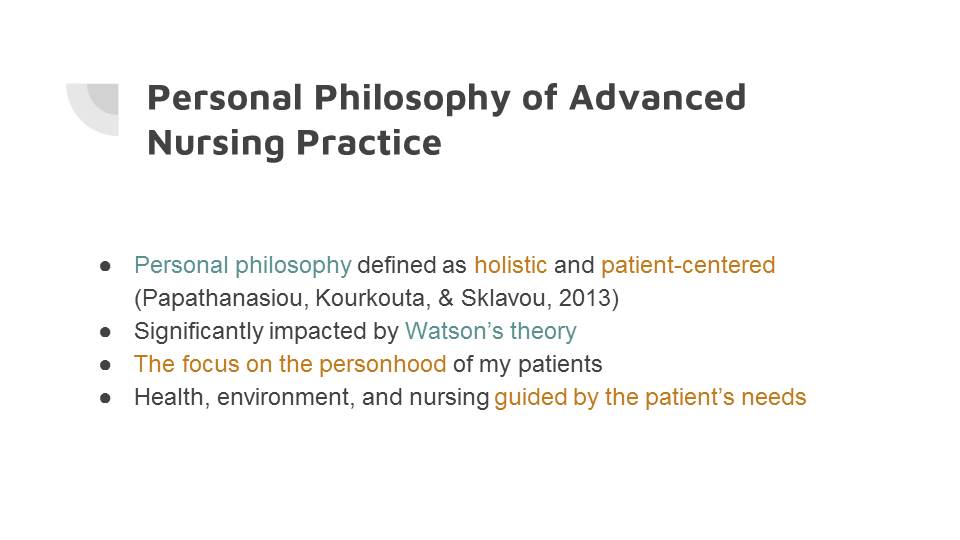
Visual Representation
Person:
- Health;
- Nursing;
- Environment.
This is the graphical representation of the interdependence between Watson’s theory, her Caring and Healing practice model, and my personal philosophy of nursing. My approach is patient-centered, and thus the concept of person is at the top of the paradigm. Health and environment are supportive aspects, which are dependent on the needs of every particular patient. The process of nursing is the primary result of the advanced practice nurse’s work, and that is why it is put in the center of the paradigm.

Conclusion
- The needs of a patient as a critical aspect of the nursing (Wagner, 2010);
- Promotion of holistic approach to nursing (Mohammed et al., 2016);
- Vastly elaborated and applicable theoretical framework (Butts & Rich, 2015);
- A personal philosophy of caring was developed;
- Improvement of caregiving processes.
The needs of a patient for dignity and respects appears to be the critical aspect of the nursing process. Also, it is evident that both the theory under discussion and the personal philosophy promote the holistic approach to nursing. Jean Watson’s theory was chosen for this presentation since it is vastly elaborated and highly applicable to practice. It includes theoretical and philosophical assumptions as well as the model of practice. It is also evident that Watson’s theory has a significant impact on the development of my philosophy of person-centered care, which I wish to implement in my advanced practice nurse role.
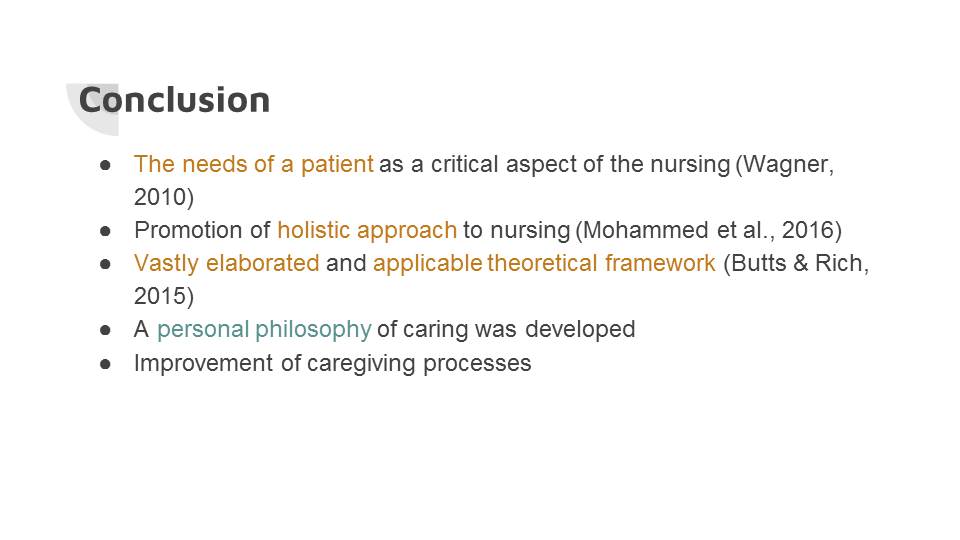
References
Papathanasiou, I., Kourkouta, M., & Sklavou, L. (2013). Holistic nursing care: Theories and perspectives. American Journal of Nursing Science, 2(1), 1-5.
Wagner, A. L. (2010). Core concepts of Jean Watson’s theory of human caring/caring science. Web.